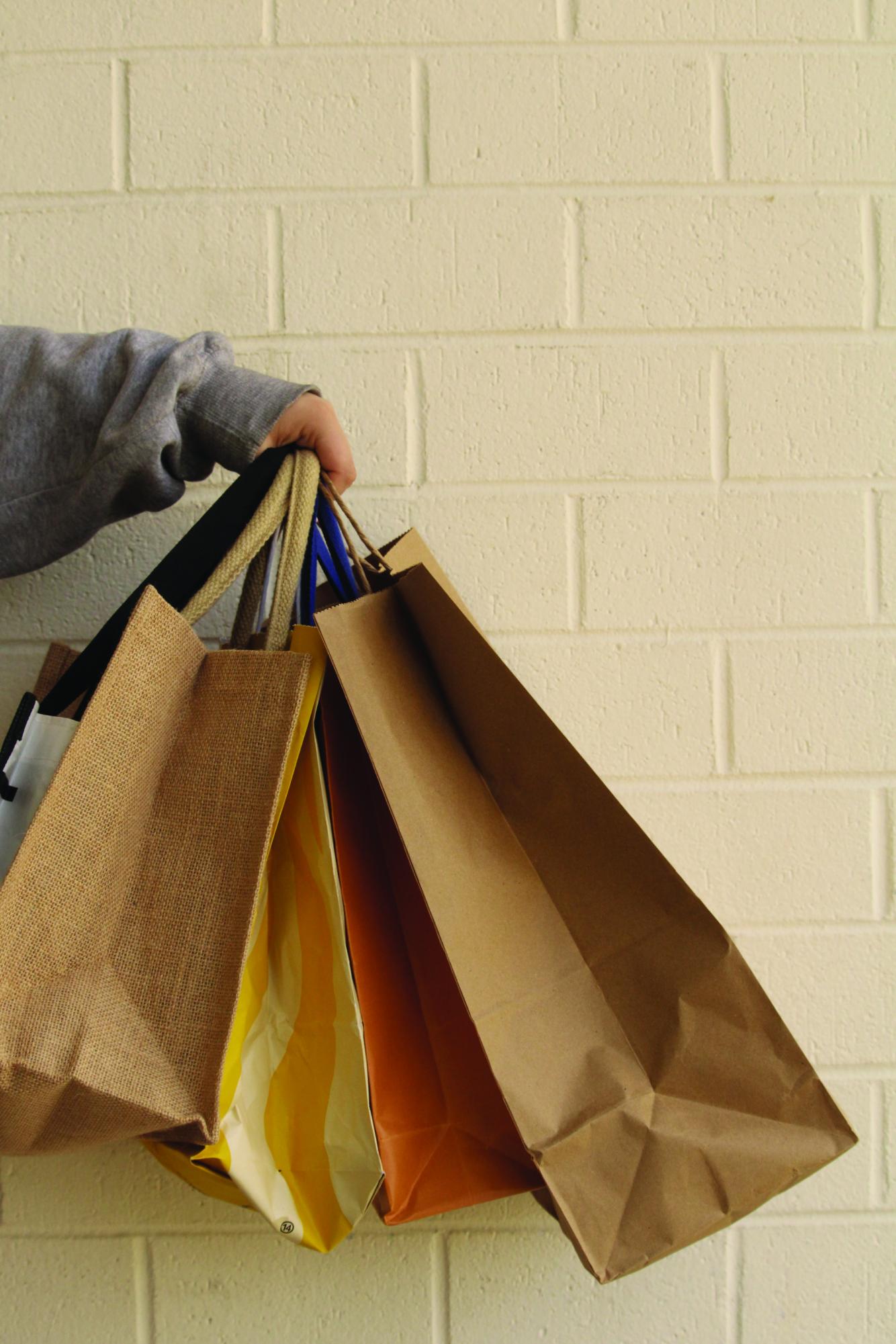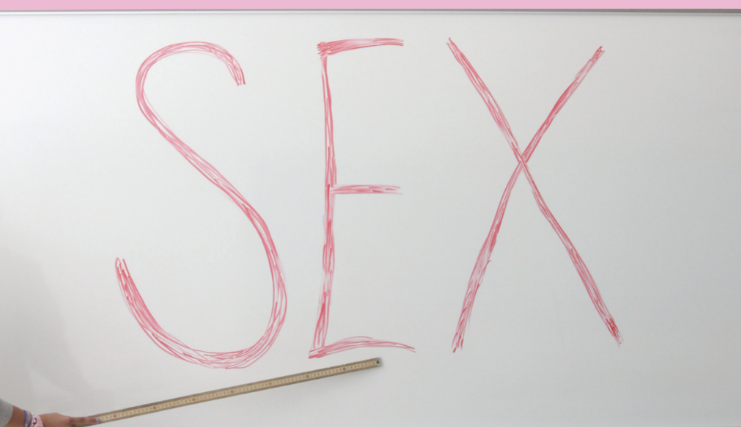Bye bye buy
As humanity progressed into the modern industrial age, it tore down many barriers to consumption. Nowadays, many people, especially in the United States, eat heaps of food, upgrade their electronics on a yearly basis and go to stores to buy excessive things for the simple joy of doing so. This phenomenon is referred to as overconsumption: spending or consuming beyond one’s means or necessity.
In the United States, overconsumption is multifaceted. The average citizen has the monetary capability to overconsume, meaning that people have the means to buy more than they need. According to HealThePlanet, although only 12% of the world’s population lives in North America, the continent still accounts for over 60% of private consumption.
“The end goal of consumerism isn’t to make people’s lives better. The end goal of consumerism is to make a product that people buy, that sells, and then sell it for as much and to as many people as possible,” junior and President of the Ecosystem Restoration club, Oliver Silver said. “It does build industry, and does sometimes improve people’s lives, but it more frequently does the opposite.”
In the 1990s, the fashion brand Zara declared their intention to take a product from design stages to creation within 15 days, in order to match the quickly changing nature of clothing trends. The New York Times described the goal as fast fashion, a strategy that has remained prominent to this day, as brands like Shein, H&M, Uniqlo and many more embrace it.
According to the documentary film “A True Cost,” people purchase 400% as much clothing today as they did 20 years ago, which is a product of fast fashion and encourages manufacturers to produce more.
According to Devorah Berman, track and field coach and CESJDS parent of senior Jonah Berman, sophomore Caleb Berman and eighth grade student Zach Berman, overconsumption can result from materialism.
“People equate the value of their life to the goods they’re able to buy, and that’s the worth of your life,” Berman said. “Worth and value shouldn’t be tied to what you own or where you can travel.”
To keep up with changing trends, many factory workers are employed in harsh conditions. An undercover report by Business Insider found that Shein workers often work for well below minimum wage and for over 18 hours per day, a circumstance common for many businesses that promote fast fashion.
Sophomore Brielle Bassin believes fast fashion is a major way JDS students contribute to overconsumption. She says that many students buy clothing according to new and popular trends, which are constantly changing, leading to a lot of waste.
“New [trends] keep arising,” Bassin said. “And people always want what’s ‘in.’ And I feel like a lot of people feel judged if they don’t have what’s ‘in.’”
Because of this desire to wear the “right thing,” many unnecessary products are bought, and ultimately wasted once a new trend comes around.
Overconsumption of products transcends the fashion industry, with the technology industry finding ways to incentivize overconsumption through promoting overbuying and unnecessarily upgrading technology. Statista found that in 2018, the average North American owned eight tech devices, yet within only five years, this number increased to 13, a 63% increase.
“There’s all this marketing telling you that you’re not cool and you’re behind the times if you’re not buying new electronics regularly,” Ecology teacher Rustom Meyer said. “We should not base our society on trying to convince people to buy things they don’t need.”
The process of overconsuming technology has adverse effects, with the National Institutes of Health (NIH) reporting that technology is reliant on non-renewable sources, specifically ones that are at risk of depletion.
Major overconsumption of food is another issue prevalent in society, with over 40% of Americans crossing the obesity threshold as a result of buying and eating too much. There is a lot of recklessness in food consumption as well, with Feeding America reporting 92 billion pounds of food waste from Americans.
“A lot of times people feel like they have a bit of something and have to have more of it because it will make them feel better,” Silver said.
It may not be very apparent, but overconsumption influences people every day. Small daily purchases can rack up, leading to overspending and a lack of financial stability, according to Dr. Leora Klapper, JDS parent and Lead Economist in the Development Research Group at the World Bank.
“When you educate people on managing a budget and making it easier for people to save for long-term goals, the thing we see the biggest impact on is spending on impulse purchases,” Klapper said.
According to Nerdwallet, 84% of Americans with a monthly budget report going over that budget. And of those, 44% say that they use their credit card to spend when going over budget.
As the use of technology increases, it becomes easier to make purchases without truly understanding their weight. According to Klapper, this is particularly true for teens who have grown up in the digital age.
“It’s too easy, especially for teens who may have access to digital channels,” Klapper said. “Having Apple Pay on your phone that’s linked to somebody else’s card allows teens to spend without necessarily keeping track of how all these small expenses add up.”
People can very easily get sucked into overconsumption, according to Dr. Alisa Schwartz, JDS parent of junior Sophie Schwartz and clinical physiologist. There are many external factors that can contribute to overconsumption, including social media, stress and peer pressure.
According to Schwartz, overconsumption has been pathologized, meaning that it has become a problem and is viewed as unhealthy, even though that may not entirely be the case. While this can be perceived negatively, it is, in some cases, just human nature.
“I think it’s very normal, especially when you’re in middle school and high school, to care a lot about what other people have and often to either want to be very similar and to fit in or to define yourself by being different,” Schwartz said. “But I think that right now, because of the coming together of a whole bunch of factors, social media being one of them, the access to seeing what so many people have, and then a time of a lot of stress in out world, people are drawn to higher levels of consumerism, and it can get to a point where it is unhealthy.”
Overspending as a result of overconsumption is also ever-growing. For this reason, continued purchasing creates a pattern that leads people to continue spending more. This continued spending, according to Silver, employs people to associate spending with joy, leading to further negative impacts of consumerism.
“It’s also important to keep people from falling too heavily into a consumerist mentality,” Silver said. “And make sure people don’t have a mentality of happiness can only be brought through money and consumption.”
Global warming has been a prevalent topic for the past 20 years, and overconsumption has been one of the most significant human contributions. According to sentientmedia.org, due to the rise in overconsumption, humans are using the Earth’s resources faster than they can be replenished, which may lead to a depletion of natural resources.
According to the World Wildlife Fund, the amount of plastic in the ocean will quadruple by 2050, and according to the Millennium Alliance for Humanity and Biosphere, global oil reserves could be completely empty only two years later. While there are many factors that contribute to these statistics, overconsumption is a major factor.
With many items coming in single-use packaging and plastics being overconsumed daily for convenience, the ecosystem will face severe consequences due to human actions. Along with this, the use of oil in manufacturing plays a significant role in concerns for the environment.
“For non-renewable resources, if [we’re] planning to have a civilization that lasts, we ought to be conserving them and using them very carefully, because when we run out, it’s gone,” Meyer said. “And so we need to figure out how to recycle what we have in order to be able to continue using things made out of these substances.”
In addition to a depletion of natural resources, overconsumption generates a huge amount of pollution and waste. According to the Environmental Learning Center, manufacturing goods leads to the release of harmful pollutants into the air and water. For example, plastic production contributes to greenhouse gas emissions because the plastic is derived from fossil fuels, and fast fashion leads to water pollution due to its frequent use of toxic chemicals.
In terms of the environment, the long-term consequences of this overconsumption, which enhances climate change, include rising sea levels and an increase in extreme weather events.
Overconsumption impacts the economy significantly. It boosts short-term economic growth by increasing individuals’ spending, which in turn leads to job creation. On the flip side, consumerism causes environmental damage, which costs the global economy over five trillion dollars every year, according to the World Economic Forum.
“Our economy depends on consumerism,” Berman said. “Because we live in a capitalist society where you have to make more goods in order for people to have jobs.”
Overconsumption in society has been around for years now, and while it is not near an end, there are steps that can be taken on an individual level to combat individual overconsumption.
While, according to Klapper, financial literacy is primarily taught through experience, there are ways to prepare the younger generation to understand and manage their own finances. This is something that JDS has begun working towards through their various new social studies-elective course offerings for the 2025-2026 school year, which are intended to help students learn more about economics.
“There should be a personal finance class where you learn concepts like inflation, diversifying your savings, the importance of setting up a retirement fund for your very first job so that your money can grow exponentially between when you’re young and when you might retire,” Klapper said.
There are also things that can be done personally to prevent ones own overconsumption. According to Bassin, putting more consideration and thought into each purchase is one way to ensure that shoppers are not unnecessarily purchasing items.
“If you’re going to buy stuff, think, are you really going to wear it in three years, or is it just what’s trending now?” Bassin said. “Thinking in the long run and seeing what you truly need instead of want. We need to separate our needs and wants.”
Shoppers must ensure that they are considering which stores they shop at, according to Berman. She emphasized that many brands do not support their employees well financially, and do not consider their companies’ environmental impact. Purchasing from those stores may appear to be the more convenient decision, but it may not be the best choice, as customers would be supporting poor work environments.
To prevent this, Berman believes it is critical to know the brand that a person is shopping from and do sufficient research before purchasing.
“Ultimately, if you can, if you support better quality companies that treat their employees well and provide living wages and produce the least amount of harm on the environment,” Berman said.
Social media also plays a role in overconsumption. With influencers and internet figures spending excessive amounts on clothing and advertising products, the pressure to buy more is increased.
According to Bassin, the Internet is built to cater to each person, meaning that it can influence people on an individual level and promote the overconsumption of items specific to each person.
“It’s also problematic that influencers will influence you to buy the new thing,” Bassin said. “…The algorithm is different for everybody. There are so many new trends coming in every day. So I think that social media is a big factor.”
Something besides being influenced that can be done is, when someone is done with a piece of clothing, rather than allowing it to sit in ones closet, consider repurposing it. According to Bassin, altering a piece of clothing to something more to your taste is not only resourceful, but can be an engaging and rewarding project.
Repurposing not only entails making a person reshape their own piece, but also allow another to do so. According to Bassin, whether it be reselling or donating items one is no longer interested in, allowing someone to make use of something you no longer has a use for prevents waste and encourages others against overconsumption of fast fashion and new products.
“I think we need to make it more of a norm to donate things to thrift shops and things like that, where people who need it can actually use it, instead of just collecting dust,” Bassin said.
While the impacts of overspending might seem minute, there are larger implications in the habit of overspending. These will influence the younger generations in the long term, according to Klapper.
“Probably no one in your grade is going to go bankrupt because of overspending in Sephora,” Klapper said. “However, it’s important to build spending and saving habits now, which you can bring into adulthood, including the importance of setting a budget, which will help you plan for longer-term financial goals, like a vacation or your own car, and learn to avoid impulse purchases.”











